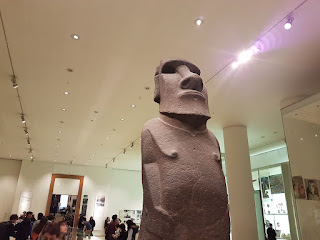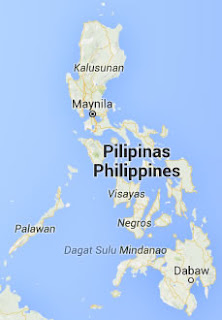Saturday I did a new thing, a day trip to London.
I know it's not the first time I visit a European capital in one day thanks to a low-cost flight, but it's the first time I do it without spending a euro, or rather without spending a pound :)
As usual, the necessary premise: one day just is not enough to see a big city like London, but we say that with a good step and with a good organization, you can see the main things, especially if you decide to move even with public transport.
In my case however, I had already been in London, so I decided to devote myself to what I had not been able to see the first time - the British Museum.
The primary purpose of this day trip to London was therefore to see the British Museum, then all that would come out would be well accepted.
But let's go for the order, the flight.
Looking for the internet, not even a week before, I found an unbeatable offer to fly to London in the day, with a good time at 8am and a return flight at 6pm.
Of course, it was not the nearest airport where I would land, it was Stansted airport, but in the end, with a good train, in about 40 minutes you're in town.
So I got the Stansed Express, the equivalent of our Malpensa Express, but it's definitely much cheaper (about 30 euros if you do not book it much sooner).
But we come to the London speech on foot in one day.
Because you will walk to you, there was already little time left.
True, but having spent a fair amount of euros for moving from airports to the city (so much so that it has reached the cost of the plane), I said, "If I change the money it ends I'll drop another 50 euros in fluency" .
From there my decision to book all the trips from Italy, to bring me food, and to travel on foot, without spending a penny then :)
I could also take the daily card of the car from Italy, but it would never arrive in time, so here I am here to walk London on foot.
According to the logbook, I would arrive by train at Liverpool Street Station, which, looking at google maps, did not seem so far away from my destination.
So I decided to get to the British Museum on foot, so much during the hour (45 minutes actually) walking, I would have seen and mostly photographed so many things, making an itinerary that I probably skipped last time.
After arriving at the museum, having first studied the 10 things not to miss the British Museum, I started the visit, bouncing from room to room.
I do not know if I've seen it all, maybe some room has escaped (I've been a couple of oats, I'm not one who reads all the insignia: p), but I was very pleased with my visit.
A small note about the British Museum: it's one of the largest history museums in the world and it's free ... a beautiful moral slap for some of our museums, which in comparison are microscopic and discreetly dear ones (eg 900's Museum) .
Anyway, after the museum, a little break in a park for lunch at the bag, and I'm ready to take a nice walk around the city.
Initially, I had thought of going to see the famous Binario 9 3/4 (Platform 9 3/4), where Harry Potter and his mage friends teletrasportano, then I remembered not to be a fan of the saga: p
More than that because I had to go to the opposite side of all the other attractions.
Then, walking along the streets of London, I noticed that the Potter is almost a national hero from these parts, so I'm a little sorry.
Another attraction that I skipped is Little Venice, a London area comparable to our Venice, and a bit even in Amsterdam.
However, having seen them both, and always for the talk that was on the opposite side of where I wanted to go, I jumped it reluctantly.
But then I did it again, with a walk lasting until about 16, where I saw many things in London, some already seen before, other unpublished (eg the Chinatown ceremony for the Buddha's birthday anniversary, and a ' Isolated musical parade with a lot of military).
Of course, I'm also a bit off the Thames, admiring the Big Ben, the Westminster Abbey, the London Eye, St Paul Cathedral, the Shard, some parks, the London beach, and getting to admire the Tower Bridge.
In the end, exhausted after a day in London on foot, I went back to take the shuttle-train to the airport, and returned to Italy.
What about this yet another low-cost experience?
First of all it was a nice exception, for two reasons.
The first was to find the flight at a very low price without much notice (usually I move a few months earlier), the second was the choice not to change money, and to make a day trip at no cost (if you exclude Travel to and from the city).
In all this walking, I obviously also shot some nice videos, which I added to last year's playlist, viewable at this address:https://www.youtube.com/playlist?list=PLCBrso9WwkFYlTz1ejdFtG65ORx2C3KiA
London is a beautiful city, certainly to be deepened in its details, but if you are not a fanatic of museums, and you like to move independently, without staying locked in a place, then such a tour has its own why.
In my opinion, there are also many trips to London (if they cost just as much in this case).
It's true, for a taste of the major attractions just one day (if you exclude those a little out of the way), especially if you travel with the metro, but London has so many things to look into, so if you like the taste, Then you will definitely want to go back, just like you did to me.
I know it's not the first time I visit a European capital in one day thanks to a low-cost flight, but it's the first time I do it without spending a euro, or rather without spending a pound :)
London in one day, walking without using public transport
As usual, the necessary premise: one day just is not enough to see a big city like London, but we say that with a good step and with a good organization, you can see the main things, especially if you decide to move even with public transport.
In my case however, I had already been in London, so I decided to devote myself to what I had not been able to see the first time - the British Museum.
The primary purpose of this day trip to London was therefore to see the British Museum, then all that would come out would be well accepted.
But let's go for the order, the flight.
Looking for the internet, not even a week before, I found an unbeatable offer to fly to London in the day, with a good time at 8am and a return flight at 6pm.
Of course, it was not the nearest airport where I would land, it was Stansted airport, but in the end, with a good train, in about 40 minutes you're in town.
So I got the Stansed Express, the equivalent of our Malpensa Express, but it's definitely much cheaper (about 30 euros if you do not book it much sooner).
But we come to the London speech on foot in one day.
Because you will walk to you, there was already little time left.
True, but having spent a fair amount of euros for moving from airports to the city (so much so that it has reached the cost of the plane), I said, "If I change the money it ends I'll drop another 50 euros in fluency" .
From there my decision to book all the trips from Italy, to bring me food, and to travel on foot, without spending a penny then :)
I could also take the daily card of the car from Italy, but it would never arrive in time, so here I am here to walk London on foot.
According to the logbook, I would arrive by train at Liverpool Street Station, which, looking at google maps, did not seem so far away from my destination.
So I decided to get to the British Museum on foot, so much during the hour (45 minutes actually) walking, I would have seen and mostly photographed so many things, making an itinerary that I probably skipped last time.
After arriving at the museum, having first studied the 10 things not to miss the British Museum, I started the visit, bouncing from room to room.
I do not know if I've seen it all, maybe some room has escaped (I've been a couple of oats, I'm not one who reads all the insignia: p), but I was very pleased with my visit.
A small note about the British Museum: it's one of the largest history museums in the world and it's free ... a beautiful moral slap for some of our museums, which in comparison are microscopic and discreetly dear ones (eg 900's Museum) .
Anyway, after the museum, a little break in a park for lunch at the bag, and I'm ready to take a nice walk around the city.
Initially, I had thought of going to see the famous Binario 9 3/4 (Platform 9 3/4), where Harry Potter and his mage friends teletrasportano, then I remembered not to be a fan of the saga: p
More than that because I had to go to the opposite side of all the other attractions.
Then, walking along the streets of London, I noticed that the Potter is almost a national hero from these parts, so I'm a little sorry.
Another attraction that I skipped is Little Venice, a London area comparable to our Venice, and a bit even in Amsterdam.
However, having seen them both, and always for the talk that was on the opposite side of where I wanted to go, I jumped it reluctantly.
But then I did it again, with a walk lasting until about 16, where I saw many things in London, some already seen before, other unpublished (eg the Chinatown ceremony for the Buddha's birthday anniversary, and a ' Isolated musical parade with a lot of military).
Of course, I'm also a bit off the Thames, admiring the Big Ben, the Westminster Abbey, the London Eye, St Paul Cathedral, the Shard, some parks, the London beach, and getting to admire the Tower Bridge.
In the end, exhausted after a day in London on foot, I went back to take the shuttle-train to the airport, and returned to Italy.
What about this yet another low-cost experience?
First of all it was a nice exception, for two reasons.
The first was to find the flight at a very low price without much notice (usually I move a few months earlier), the second was the choice not to change money, and to make a day trip at no cost (if you exclude Travel to and from the city).
In all this walking, I obviously also shot some nice videos, which I added to last year's playlist, viewable at this address:https://www.youtube.com/playlist?list=PLCBrso9WwkFYlTz1ejdFtG65ORx2C3KiA
London is a beautiful city, certainly to be deepened in its details, but if you are not a fanatic of museums, and you like to move independently, without staying locked in a place, then such a tour has its own why.
In my opinion, there are also many trips to London (if they cost just as much in this case).
It's true, for a taste of the major attractions just one day (if you exclude those a little out of the way), especially if you travel with the metro, but London has so many things to look into, so if you like the taste, Then you will definitely want to go back, just like you did to me.
































